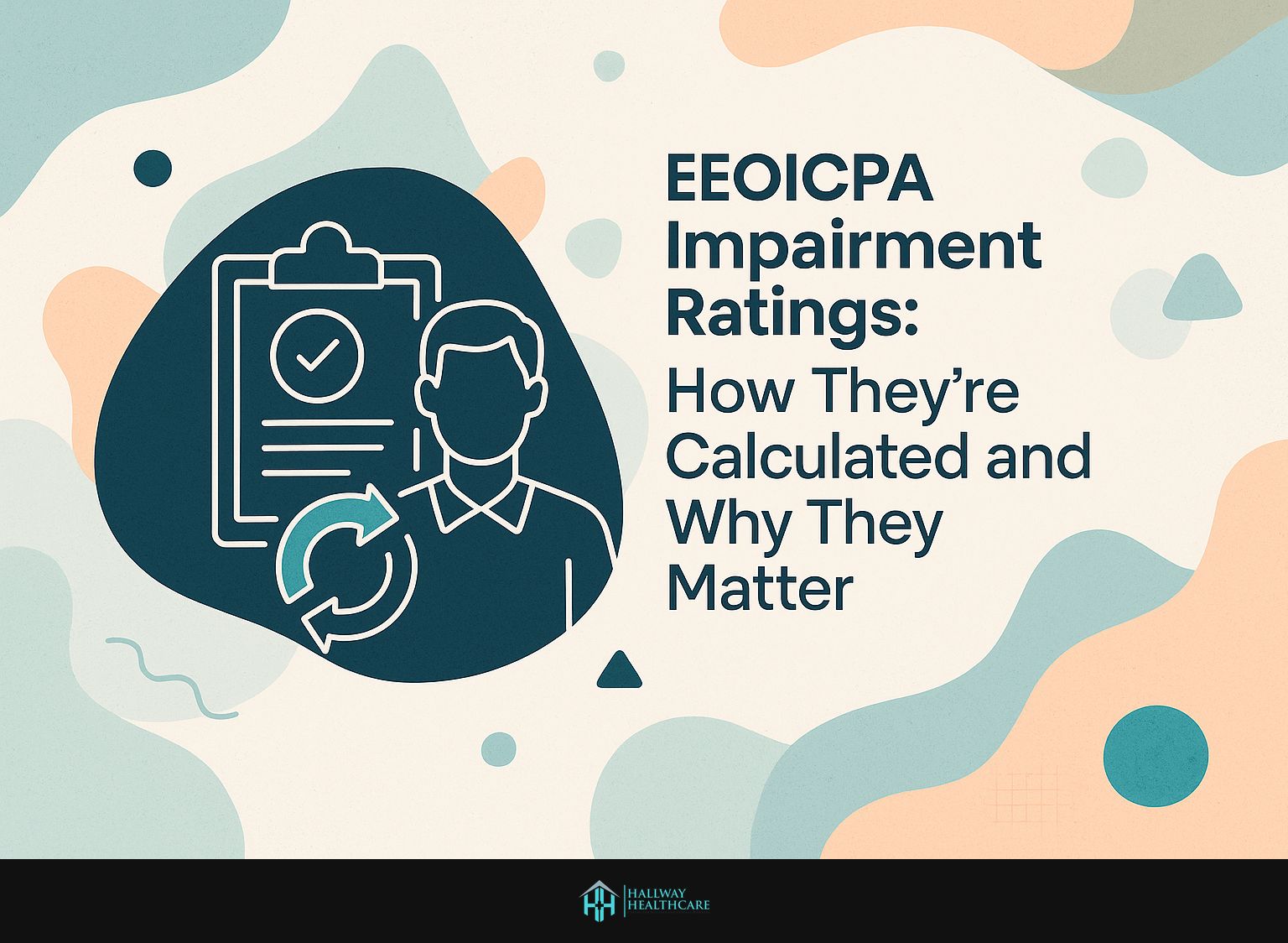
Understanding EEOICPA impairment ratings is crucial for those filing claims for covered illnesses. These ratings, determined by a Claims Examiner through procedures outlined in the AMA Guides, assess the extent of an individual’s impairment following Maximum Medical Improvement. Accurate impairment claims, supported by medical evidence and diagnostic tests, are crucial for ensuring appropriate compensation from the Department of Energy. This article explains how impairment ratings are calculated and their impact on eligibility and benefits, providing clarity to those seeking support under EEOICPA.
Key Takeaways:
- Impairment ratings determine the level of disability from occupational illnesses or injuries under EEOICPA. They are crucial for establishing eligibility and benefit amounts.
- These ratings use methods such as impairment evaluation reports, considering both physical and mental impairments.
- Challenges can arise during the impairment claim process, emphasizing the need for consistent and accurate ratings for fair compensation.
Overview of EEOICPA
The Energy Employees Occupational Illness Compensation Program Act (EEOICPA) compensates eligible employees for work-related illnesses related to their work in nuclear weapons production. Established in 2000, the EEOICPA offers a range of benefits, including medical coverage, disability payments, and survivor benefits for individuals who were employed in the nuclear industry.
Claimants can receive support from the Department of Energy and the Department of Labor.
Recent statistics indicate that over 90,000 claims have been processed, awarding around $10 billion in benefits.
To file a claim and start the impairment award process, follow these steps:
- Collecting relevant medical records and employment documentation, including the impairment claim date.
- Submitting their application through the Department of Labor’s Energy Employees Occupational Illness Compensation Program website.
Purpose of the EEOICPA
The primary objective of the Energy Employees Occupational Illness Compensation Program Act (EEOICPA) is to ensure that workers suffering from occupational illnesses and loss of wage earning capacity receive fair compensation for their medical conditions.
To achieve this objective, the EEOICPA implements a comprehensive process for determining impairment ratings, which is essential for assessing eligibility for compensation. Workers are required to submit medical documentation that substantiates their conditions, such as lung diseases or cancers linked to exposure to hazardous substances.
The Department of Labor evaluates these claims against established impairment standards, providing compensation based on the severity and medical impact of the conditions presented.
In addition, tools such as the National Institute for Occupational Safety and Health’s (NIOSH) compensation calculators help claimants understand potential benefits, thereby facilitating their journey toward recovery.
Understanding Impairment Ratings
Impairment ratings are key in determining the compensation an employee might receive under the framework of the Energy Employees Occupational Illness Compensation Program Act (EEOICPA).
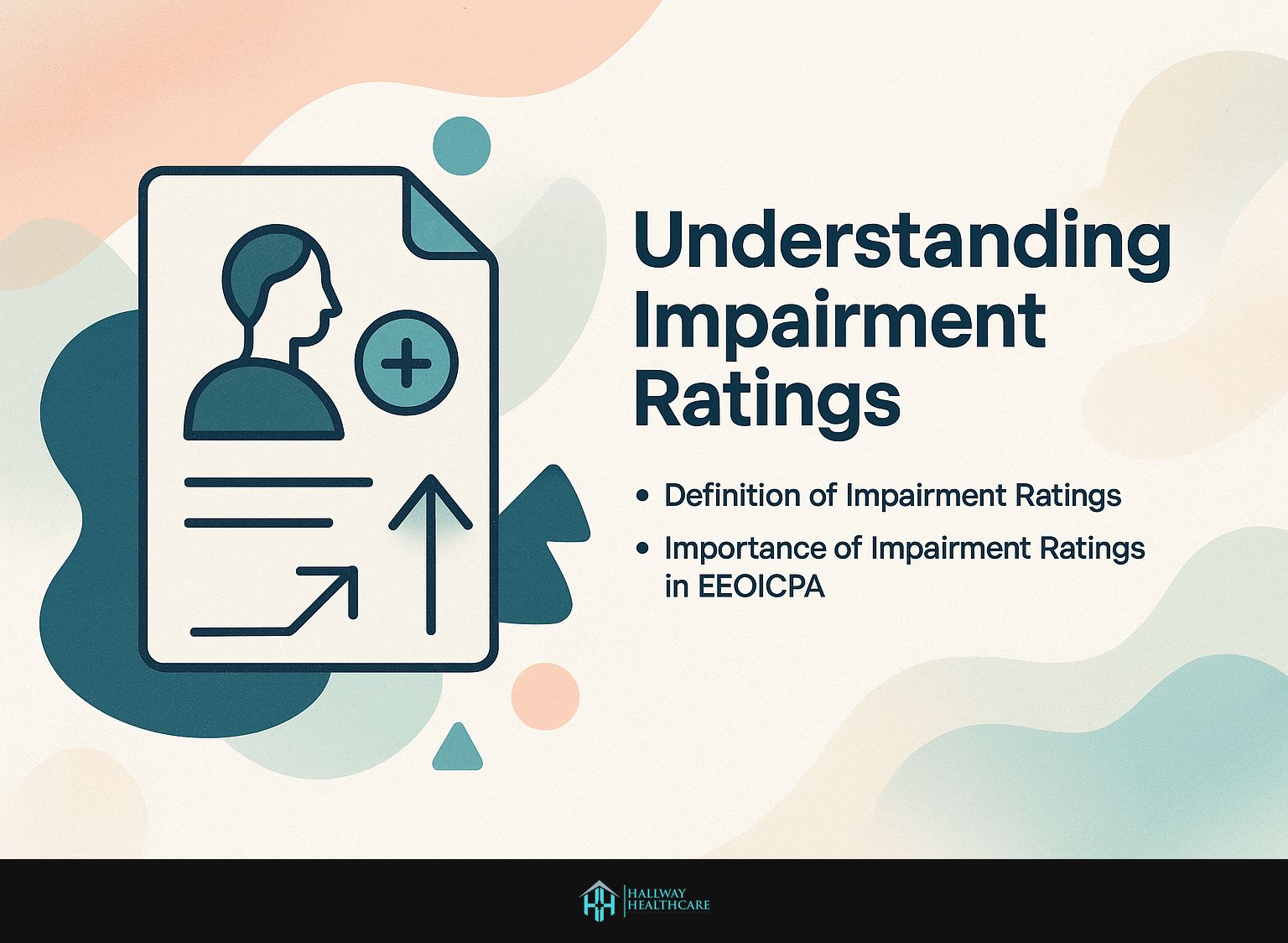
Definition
Impairment ratings are defined as evaluations of the extent of functional loss resulting from medical conditions, typically expressed as a percentage. These ratings are based on the American Medical Association (AMA) Guides to the Evaluation of Permanent Impairment, which offer a standardized methodology for assessment.
For example, a simple fracture might receive a 10% rating for minimal functional limitations, while a severe spinal injury could get a 30% rating for significant mobility impact.
Healthcare professionals evaluate specific criteria, including range of motion, strength, and endurance, to derive these percentages. This ensures consistent assessments across various cases.
Why It Matters
Impairment ratings are a critical component of the Energy Employees Occupational Illness Compensation Program Act (EEOICPA), as they directly determine the amount and eligibility of compensation for claimants. Each impairment rating, established through comprehensive medical evaluations, ranges from 0% to 100% and has a substantial impact on the compensation awarded.
For example, a claimant with a 10% impairment rating may receive about $50,000. In contrast, someone rated at 100% could claim over $400,000. The severity of health conditions is also a significant factor; a claimant diagnosed with lung disease generally receives higher ratings in comparison to those with minor injuries.
Claimants must understand these distinctions to appeal lower ratings effectively. By providing additional medical evidence or obtaining a second opinion, claimants can enhance their chances of optimizing their compensation outcomes.
How to Calculate
Calculating impairment ratings involves specific methods to evaluate functional loss from occupational illnesses like chronic beryllium disease.
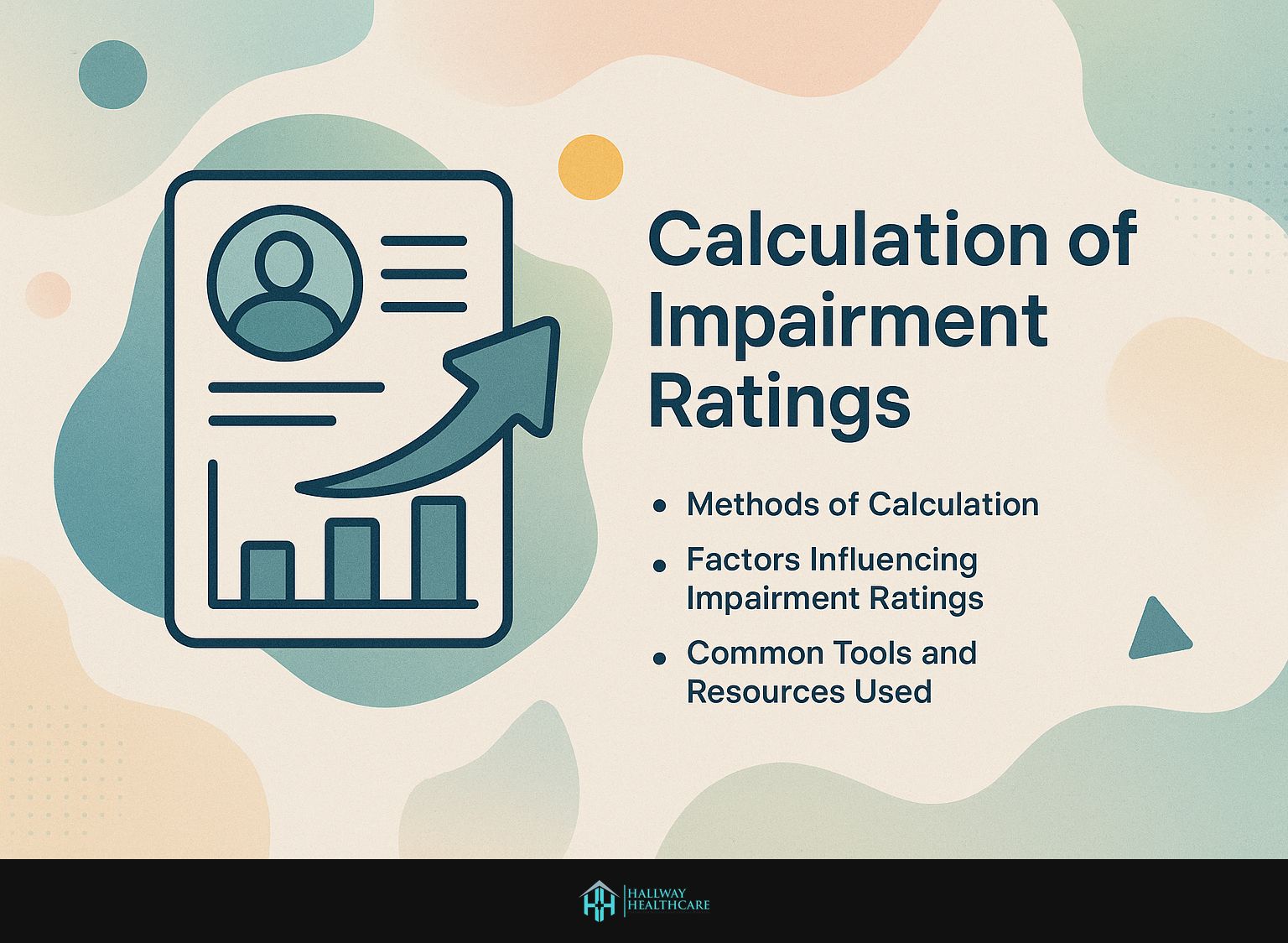
Methods of Calculation
The calculation of impairment ratings necessitates a thorough evaluation by a qualified physician, along with a careful review of medical records.
Medical professionals follow the American Medical Association (AMA) guidelines to ensure accuracy in determining impairment ratings. This process typically involves the utilization of the AMA Guides to the Evaluation of Permanent Impairment, which delineates specific assessment criteria.
Physicians commence the impairment evaluation by reviewing the individual’s medical history and conducting a comprehensive physical examination, as guided by medical treatment guidelines. They may also employ specific models, such as the Whole Person Impairment (WPI) model, to quantify the degree of impairment.
Working with occupational therapists enhances the assessment process. It provides a better understanding of the individual’s functional capabilities and limitations.
Factors Influencing Ratings
Several factors influence impairment ratings. These include the severity of the medical condition, medical history, and the ability to perform daily activities.
Chronic conditions are evaluated through a combination of medical evidence and personal reports. For example, an individual with advanced arthritis may exhibit difficulty in performing tasks such as dressing or bathing, which can affect their impairment rating.
Evaluators frequently utilize standardized assessments, such as the Barthel Index, which measures specific daily activities, to prepare an impairment letter. Comprehensive documentation from healthcare providers outlining treatment history and functional limitations is essential in this process.
Understanding the criteria and presenting thorough evidence can significantly impact outcomes. This leads to more accurate and favorable impairment ratings.
Common Tools and Resources Used
Many tools and resources help accurately calculate impairment ratings. These include the AMA Guides and various assessment forms. The AMA Guides are essential for providing a standardized approach that outlines the consistent assessment of physical and mental impairments.
Forms like Form EE-11A streamline evaluations. They guide assessors through critical steps in the assessment process. For more comprehensive evaluations, it is advisable to utilize software solutions like MedCalc or EasyMeasure, which offer calculators designed for various impairment scenarios.
To enhance one’s understanding, it is recommended to visit the American Medical Association’s website or refer to their publications for updated methodologies and guidelines, including evaluation procedures, thereby ensuring that assessment processes remain accurate and compliant.
Categories of Ratings
Impairment ratings can be categorized into distinct classifications, including physical and mental impairments, each defined by specific assessment criteria.
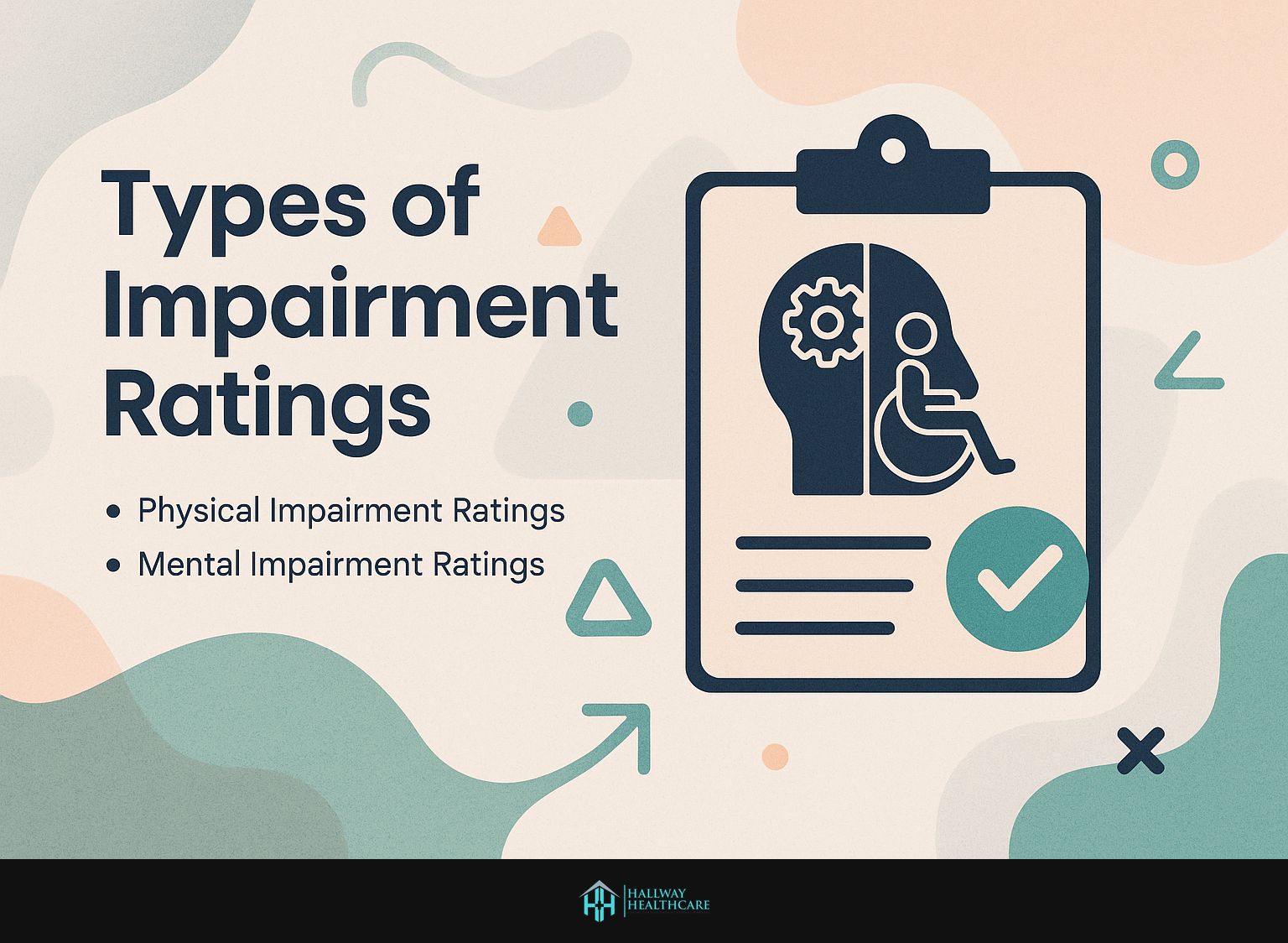
Physical
Physical impairment ratings evaluate the functional loss in specific body parts. They contribute to the overall percentage of whole person impairment.
Evaluators consider various conditions like arthritis. Impairment ratings can range from 10% to 50%, depending on severity.
Limb amputations receive ratings from 30% to 70%. This depends on the limb’s importance to mobility and daily activities. The assessment process includes a medical examination, mobility evaluation, and a review of medical history.
Resources like the AMA Guides help determine impairment percentages. They ensure a standardized evaluation approach.
Mental
Mental impairment ratings evaluate psychological conditions. These conditions affect daily functioning and quality of life.
Assessing mental impairments uses standardized evaluations. The Diagnostic and Statistical Manual of Mental Disorders (DSM-5) outlines these.
Conditions commonly rated include those outlined in the Radiation Exposure Compensation Act:
- Depression impairment ratings
- Anxiety disorders
- Post-traumatic stress disorder (PTSD) affecting Activities of Daily Living
Each condition receives a rating based on severity and its functional limitations. For example, a moderate depressive disorder may be assigned a lower rating compared to severe PTSD, which subsequently informs the benefits and claims decision for impairment benefits.
These ratings are crucial for determining monthly benefits and access to vocational rehabilitation and mental health services. Accurate assessment by the rating physician is vital for claimants seeking support.
Impact on Benefits and Compensation Coordination
The impairment rating significantly influences the benefits under the Energy Employees Occupational Illness Compensation Program Act (EEOICPA). It determines eligibility and compensation amounts, considering tort offset.

Eligibility for Compensation Under Federal EEOICPA
Eligibility for compensation under the Energy Employees Occupational Illness Compensation Program Act (EEOICPA) is contingent upon the impairment rating assigned to an individual’s medical condition.
To secure these benefits, file impairment claims on time. This involves gathering all relevant medical documentation, including the impairment evaluation report. Ensure it accurately reflects the diagnosis and its impact on daily living.
Using resources like the EEOICPA’s online claims system can help you submit your application efficiently, especially Form EE-11A.
Stay attentive to deadlines. Claims typically must be submitted within a specific timeframe after diagnosis. Delays may compromise eligibility. Therefore, maintain open communication with healthcare providers and the Claims Examiner. This ensures consistent updates and accurate health records to support your claim.
Determining Benefit Amounts and Body Part Impairment
Determining the compensation amount requires assessing the impairment rating alongside other factors like medical history and wage loss, considering Maximum Medical Improvement.
The process starts by obtaining the impairment rating from a qualified medical professional, usually ranging from 0% to 100%. Each percentage correlates with specific compensation values detailed in state guidelines. For example, a 25% impairment rating may correspond to $50,000, while a 75% impairment could be valued at $150,000.
It is essential to document the medical history and any wage losses. These elements can significantly strengthen the claim. Using tools like state compensation calculators can provide precise estimates tailored to individual circumstances.
Challenges in Calculations and Hearing Process
Calculating impairment ratings can be challenging. These challenges may lead to disputes and appeals, which affect the claims process.
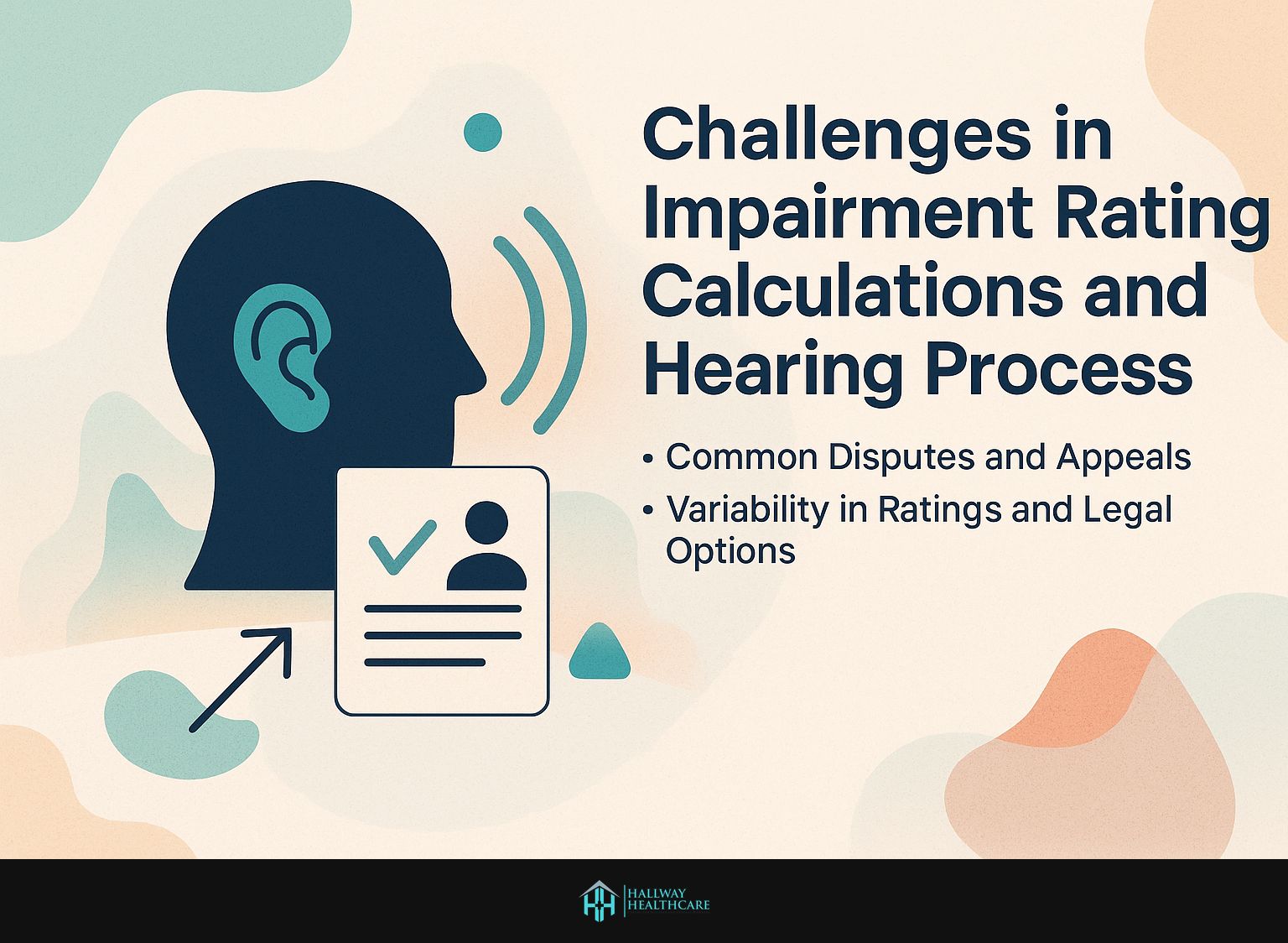
Common Disputes and Appeals
Disputes often occur during the impairment rating process. These can prolong compensation timelines. Common sources of these disputes include discrepancies in ratings, where the assigned rating does not correspond with the medical evidence or the limitations reported by the claimant, requiring a written statement.
To initiate an appeal, it is crucial to gather comprehensive documentation, including medical records and prior reports that support your case.
Submit a clear letter outlining your arguments. This is essential for the appeal process. The outcomes of appeals may vary; some may result in increased ratings, while others could lead to requests for further evaluations by the Division of Energy Employees.
Good preparation and attention to detail can impact your appeal’s outcome.
Variability in Ratings and Legal Options
Variability in impairment ratings can occur due to different evaluation methods. This leads to inconsistencies in compensation decisions. For example, two physicians may assess the same injury and provide differing impairment ratings due to variations in their training and assessment tools, such as following AMA Guides versus personal experience.
One physician might adhere to standardized guidelines established by the American Medical Association, while the other may depend on personal experience or regional standards.
This discrepancy highlights the importance of seeking a second opinion. Consulting multiple physicians helps ensure accurate assessments.
Case Studies and Examples with the Division of Energy
Real-life case studies provide valuable insights into impairment ratings and their outcomes. This is especially true for chronic conditions such as Chronic Beryllium Disease.
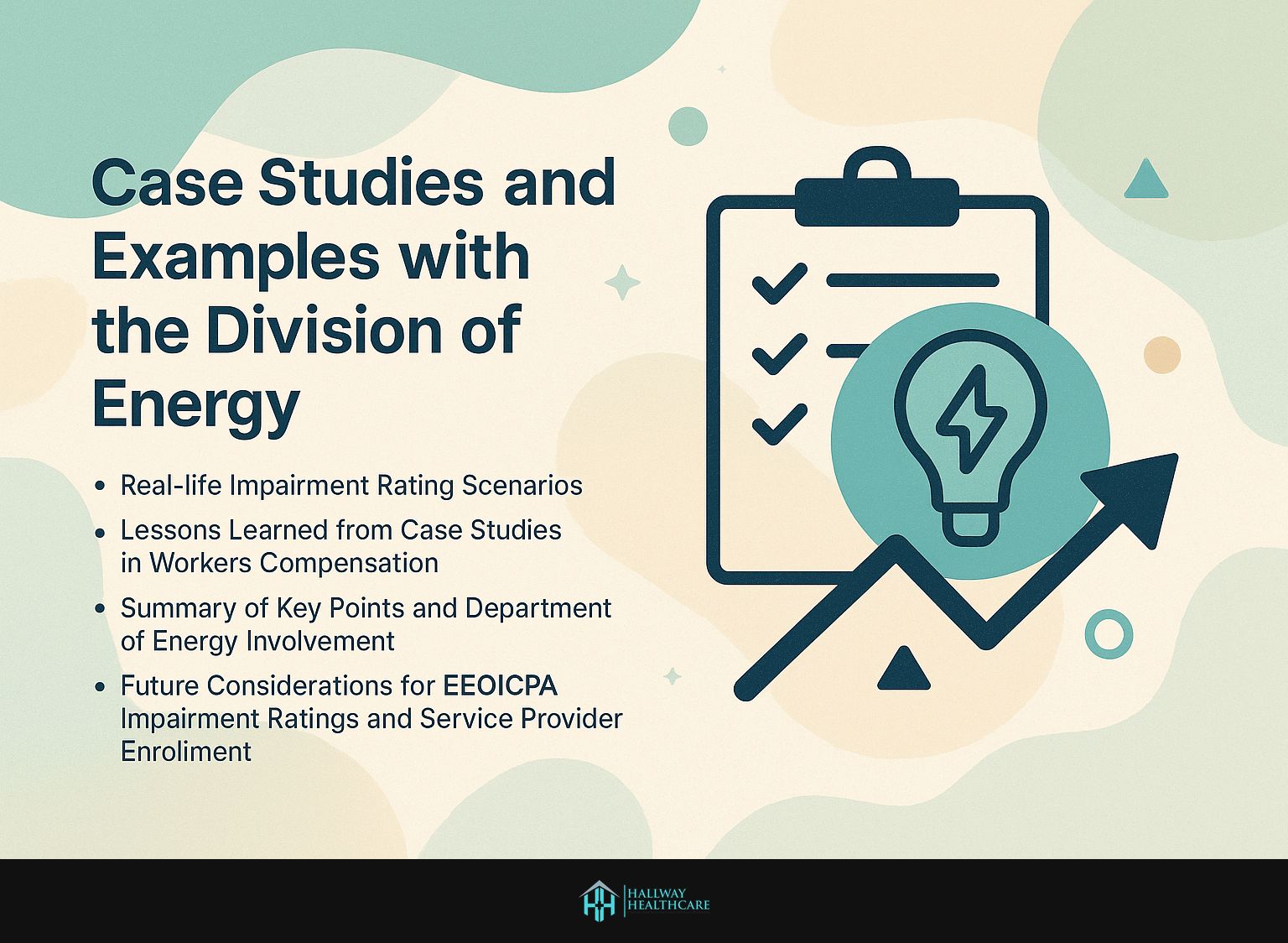
Real-life Impairment Rating Scenarios
Case studies that showcase real-life impairment rating scenarios can provide valuable insights into the complexities inherent in the evaluation process.
For instance, one case involved a worker who sustained a back injury while engaged in heavy lifting. The evaluating physician assigned a 15% impairment rating, taking into account the patient’s limited range of motion and levels of pain, as per AMA Guides.
Another case examined a victim of a motor vehicle accident, who was assigned a 10% impairment rating due to neck strain, which, while less severe, still had a notable impact on the individual’s daily functioning.
These ratings were influenced by various factors, including the nature of the injury, the progress of recovery, and the individual’s capacity to return to work. Analyzing these cases aids in delineating the nuanced criteria that are utilized in impairment assessments.
Key Lessons from Workers Compensation Case Studies
Lessons from case studies stress the need for thorough documentation. Following the requirements of the EEOICPA is crucial.
To navigate the impairment claim process effectively, focus on collecting comprehensive medical records and detailed work history, and documentation of exposure. It is imperative that all medical professionals involved are fully aware of the specific requirements mandated by the EEOICPA.
It is advisable to develop a checklist of essential documents, which may include:
- Radiographic evidence
- Pathology reports
- Witness statements
- Power of Attorney
Regularly update and review these documents to keep them accurate and complete. Additionally, consulting a legal expert in EEOICPA claims helps avoid common pitfalls that can slow your application.
Summary of Key Points and Department of Energy Involvement
Key points include the definition, significance, and calculation methods of impairment ratings under the EEOICPA.
Impairment ratings identify the degree of an individual’s disabilities. This is crucial for determining compensation under the EEOICPA. Professionals often use the American Medical Association (AMA) Guidelines to calculate these ratings. These guidelines are endorsed by the American Academy of Disability Evaluating Physicians.
For example, a worker diagnosed with a 20% impairment in a limb will have their compensation directly affected by this percentage. It is advisable to consult a specialized physician for accurate assessments, ensuring that all documentation complies with EEOICPA requirements to prevent delays in the claims process, and to consider the funding mechanism for compensation. Taking this proactive approach increases the chances of receiving a fair and timely settlement.
Future Considerations for Ratings and Service Provider Enrollment
The future of impairment ratings under the EEOICPA may change due to evolving medical standards and regulations, including updates in the Radiation Exposure Compensation Act.
These changes may greatly impact claimants. For example, revised criteria may enhance the assessment of physical and psychological impairments, thereby potentially improving the accuracy of claims.
Claimants might face challenges, as new standards may require more detailed medical documentation. Resources like the International Classification of Diseases (ICD) help healthcare professionals meet the latest criteria. Telehealth services can also make evaluations more efficient.
Claimants must stay informed about these changes to effectively advocate for their rights.
 Skip to content
Skip to content
